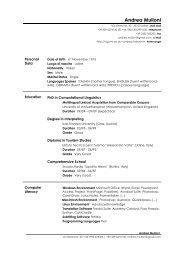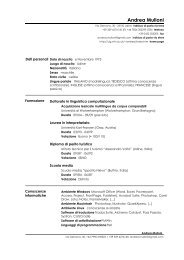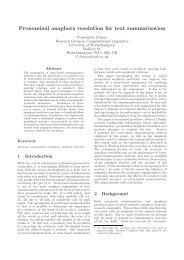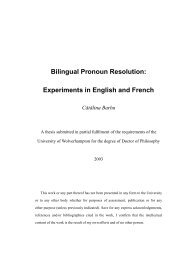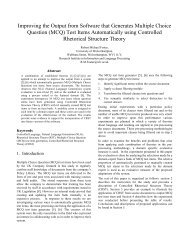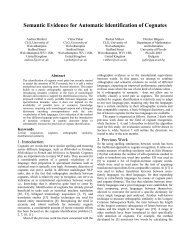Design and development of a concept-based multi ... - Citeseer
Design and development of a concept-based multi ... - Citeseer
Design and development of a concept-based multi ... - Citeseer
You also want an ePaper? Increase the reach of your titles
YUMPU automatically turns print PDFs into web optimized ePapers that Google loves.
Shiyan Ou, Christopher S.G. Khoo <strong>and</strong> Dion H. Goh<br />
contains one or more sentences. In this study, we treated discourse parsing as a sentence categorization<br />
problem, i.e. assigning each sentence in a dissertation abstract to one <strong>of</strong> the five categories or sections.<br />
In previous studies, surface cues have been used for discourse parsing, for example, cue words, synonymous<br />
words or phrases, <strong>and</strong> similarity between two sentences used by Kurohashi <strong>and</strong> Nagao [19];<br />
lexical frequency <strong>and</strong> distribution information used by Hearst [20]; <strong>and</strong> syntactic information, cue<br />
phrases <strong>and</strong> other cohesive devices used by Le <strong>and</strong> Abeysinghe [21]. However, only some sentences in<br />
dissertation abstracts were found to contain a clear cue phrase at the beginning. Thus, we selected a<br />
supervised learning method, decision tree induction, which has been used by several researchers, such<br />
as Marcu [22] <strong>and</strong> Nomoto <strong>and</strong> Matsumoto [23], for discourse parsing. Finally, cue phrases found at the<br />
beginning <strong>of</strong> some sentences were used as a complement to improve their categorization.<br />
To develop a decision tree classifier, a r<strong>and</strong>om sample <strong>of</strong> 300 dissertation abstracts was selected from<br />
the set <strong>of</strong> 3214 PhD dissertation abstracts in sociology, published in the 2001 Dissertation Abstracts<br />
International database. The sample abstracts were partitioned into a training set <strong>of</strong> 200 abstracts to construct<br />
the classifier <strong>and</strong> a test set <strong>of</strong> 100 abstracts to evaluate the accuracy <strong>of</strong> the constructed classifier.<br />
Each sentence in the sample abstracts was manually assigned to one <strong>of</strong> the five categories. To simplify<br />
the classification problem, each sentence was assigned to only one category, though some sentences<br />
could arguably be assigned to <strong>multi</strong>ple categories or no category at all. Some <strong>of</strong> the abstracts (29 in the<br />
training set <strong>and</strong> 16 in the test set) were found to be unstructured <strong>and</strong> difficult to code into the five categories<br />
<strong>and</strong> thus removed from the training <strong>and</strong> test set. A well-known decision tree induction algorithm,<br />
C5.0 [24], was used in the study. The decision tree classifier that was developed used high<br />
frequency word tokens <strong>and</strong> normalized sentence position in the abstract as features.<br />
Preliminary experiments were carried out using 10-fold cross-validation to determine the appropriate<br />
parameters for constructing the classifier, including the word frequency threshold value for<br />
determining the cue words used for categorization <strong>and</strong> the pruning severity for determining the<br />
extent to which the constructed classifier will be pruned. The best classifier was obtained with a<br />
word frequency threshold value <strong>of</strong> 35 <strong>and</strong> pruning severity <strong>of</strong> 95%. Finally, the classifier was<br />
applied to the test sample <strong>and</strong> an accuracy rate <strong>of</strong> 71.6% was obtained.<br />
A set <strong>of</strong> IF–THEN categorization rules was extracted from the decision tree classifier. An example<br />
rule for identifying the research objectives section (i.e. Section 2) is as follows:<br />
• If N-SENTENCE-POSITION



